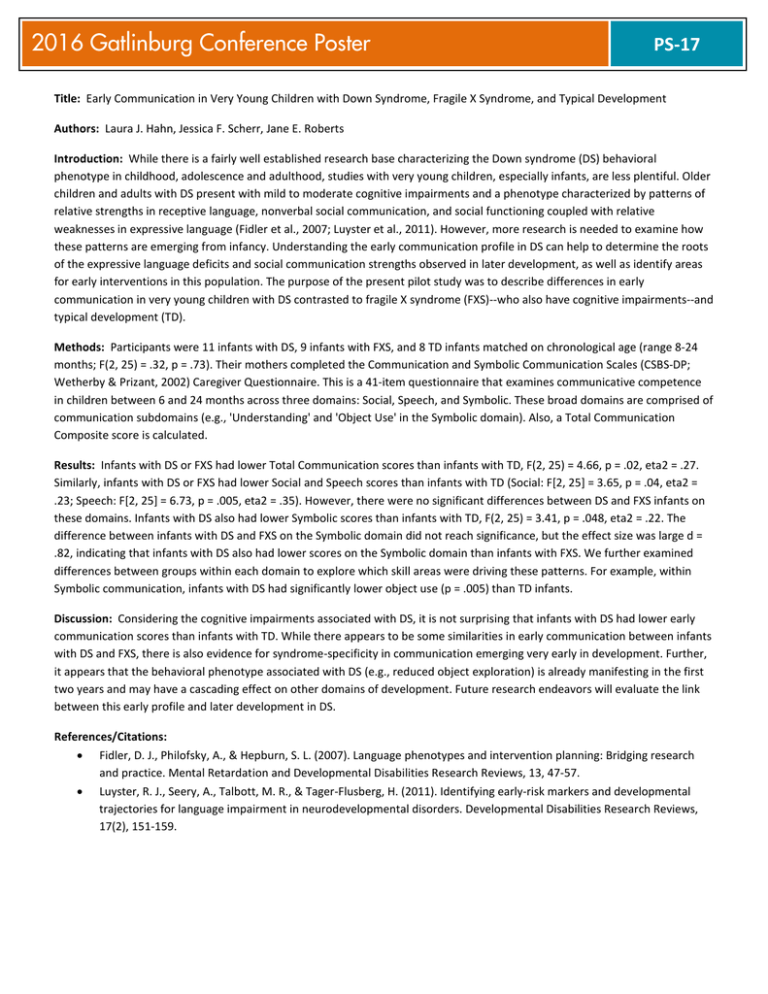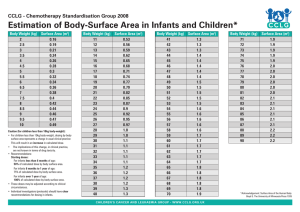2016 Gatlinburg Conference Poster PS-17
advertisement

2016 Gatlinburg Conference Poster PS-17 Title: Early Communication in Very Young Children with Down Syndrome, Fragile X Syndrome, and Typical Development Authors: Laura J. Hahn, Jessica F. Scherr, Jane E. Roberts Introduction: While there is a fairly well established research base characterizing the Down syndrome (DS) behavioral phenotype in childhood, adolescence and adulthood, studies with very young children, especially infants, are less plentiful. Older children and adults with DS present with mild to moderate cognitive impairments and a phenotype characterized by patterns of relative strengths in receptive language, nonverbal social communication, and social functioning coupled with relative weaknesses in expressive language (Fidler et al., 2007; Luyster et al., 2011). However, more research is needed to examine how these patterns are emerging from infancy. Understanding the early communication profile in DS can help to determine the roots of the expressive language deficits and social communication strengths observed in later development, as well as identify areas for early interventions in this population. The purpose of the present pilot study was to describe differences in early communication in very young children with DS contrasted to fragile X syndrome (FXS)--who also have cognitive impairments--and typical development (TD). Methods: Participants were 11 infants with DS, 9 infants with FXS, and 8 TD infants matched on chronological age (range 8-24 months; F(2, 25) = .32, p = .73). Their mothers completed the Communication and Symbolic Communication Scales (CSBS-DP; Wetherby & Prizant, 2002) Caregiver Questionnaire. This is a 41-item questionnaire that examines communicative competence in children between 6 and 24 months across three domains: Social, Speech, and Symbolic. These broad domains are comprised of communication subdomains (e.g., 'Understanding' and 'Object Use' in the Symbolic domain). Also, a Total Communication Composite score is calculated. Results: Infants with DS or FXS had lower Total Communication scores than infants with TD, F(2, 25) = 4.66, p = .02, eta2 = .27. Similarly, infants with DS or FXS had lower Social and Speech scores than infants with TD (Social: F[2, 25] = 3.65, p = .04, eta2 = .23; Speech: F[2, 25] = 6.73, p = .005, eta2 = .35). However, there were no significant differences between DS and FXS infants on these domains. Infants with DS also had lower Symbolic scores than infants with TD, F(2, 25) = 3.41, p = .048, eta2 = .22. The difference between infants with DS and FXS on the Symbolic domain did not reach significance, but the effect size was large d = .82, indicating that infants with DS also had lower scores on the Symbolic domain than infants with FXS. We further examined differences between groups within each domain to explore which skill areas were driving these patterns. For example, within Symbolic communication, infants with DS had significantly lower object use (p = .005) than TD infants. Discussion: Considering the cognitive impairments associated with DS, it is not surprising that infants with DS had lower early communication scores than infants with TD. While there appears to be some similarities in early communication between infants with DS and FXS, there is also evidence for syndrome-specificity in communication emerging very early in development. Further, it appears that the behavioral phenotype associated with DS (e.g., reduced object exploration) is already manifesting in the first two years and may have a cascading effect on other domains of development. Future research endeavors will evaluate the link between this early profile and later development in DS. References/Citations: • Fidler, D. J., Philofsky, A., & Hepburn, S. L. (2007). Language phenotypes and intervention planning: Bridging research and practice. Mental Retardation and Developmental Disabilities Research Reviews, 13, 47-57. • Luyster, R. J., Seery, A., Talbott, M. R., & Tager-Flusberg, H. (2011). Identifying early-risk markers and developmental trajectories for language impairment in neurodevelopmental disorders. Developmental Disabilities Research Reviews, 17(2), 151-159.






